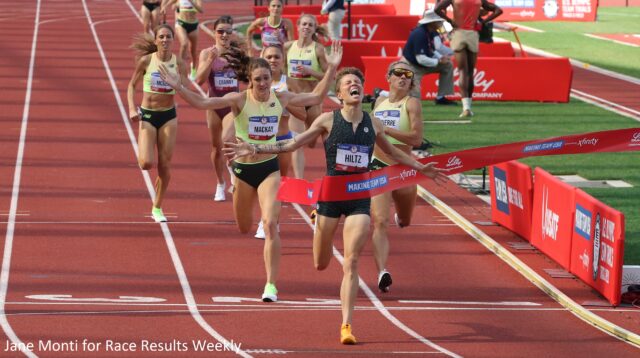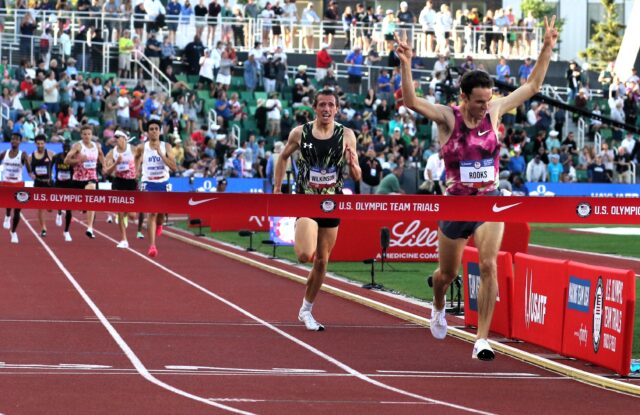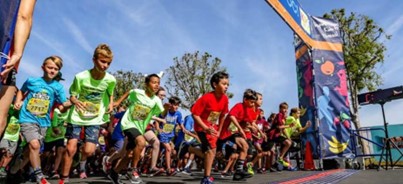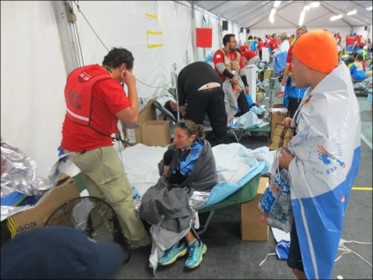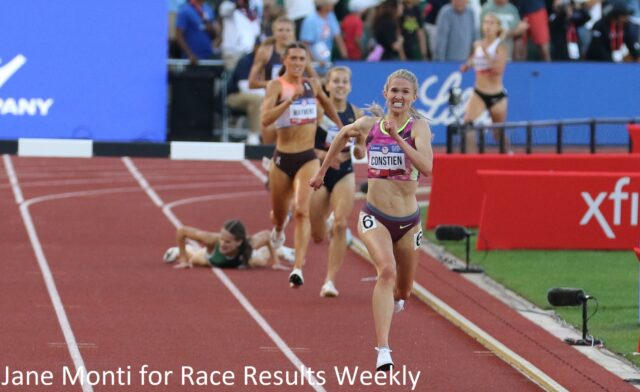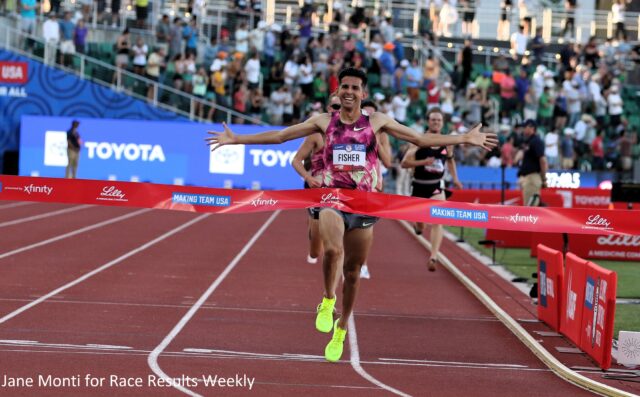With Powerful Close, Fisher Wins U.S. Olympic Trials 10,000m
(c) 2024 Race Results Weekly, all rights reserved. Published with permission.
EUGENE, ORE. (21-Jun) -– Grant Fisher surged to the front with less than three laps to go to decisively break open the men's 10,000 meters on the first night of the 2024 U.S. Olympic Team Trials — Track & Field. The American record holder was followed across the line at Hayward Field by Woody Kincaid and Nico Young, who will join him in Paris.
It was an honest race from the start with Conner Mantz --already on the Olympic team in the marathon-- setting the tempo. He was followed by a single file procession of Young, Fisher, Kincaid, Paul Chelimo and Andrew Colley. In the early laps, Mantz was towing the field at a sub-27:00 pace.
Chelimo briefly went to the lead after 4200 meters, but Mantz surged ahead half a lap later. By halfway the pace had slowed enough to allow the main chase pack of Sam Chelanga, Drew Hunter, Casey Clinger and Ryan Ford to latch onto back of the lead group.
Chelanga, 38, went to the lead at 6600 meters and opened up a small gap, but a kilometer later Young was up front. Chelimo briefly took control with three laps to go, but his challenge was short lived. With two and a half laps remaining, Fisher made his move and the field was unable to respond. As the pack broke apart, Kincaid, Young and Hunter remained in the hunt for the final two roster spots. Hunter, who does not have the Olympic qualifying standard, was the odd man out in the final half lap.
Fisher won in 27:49.47, well clear of a fast-closing Kincaid (27:50.74) and Young (27:52.40). Hunter, the former high school record holder in the indoor mile, was fourth in 27:53.35, followed by Clinger (27:59.71) and Mantz (28:00.90). Chelimo, a two-time Olympic medalist in the 5000, faded badly and came home 10th in 28:18.31.
"This definitely is validation," Fisher said, referring to his decision to part ways with the Bowerman Track Club last year and reunite with his former high school coach, Mike Scannell. "When I mapped out the year with my coach, we had an indoor plan, we had an outdoor plan, the overarching goal was to get on the team."
At last year's USA championships, Fisher was fighting an injury and finished fourth, one spot off making the team for the World Athletics Championships in Budapest. "I missed the team last year, super disappointing to watch Budapest from the couch. So to be back on the team feels really good. We targeted this race not as a qualifier, but I wanted to win. And I wanted to do it dominantly, and I wanted to show myself that I'm still the best guy in the country."
He will also attempt to make the team in the 5000 meters when that event begins next week.
Kincaid said he missed about 10 days of training in late April with an injury, so wasn't sure what to expect in this race. "Nobody likes coming into the Olympic Trials having not raced in three months," he said. "Even at 31 I thought I would be more confident coming in, but nope, still nervous."
Still, he knew his closing speed was his not-so-secret-weapon (he closed in 55.8 seconds). "I would like to have not relied on the kick, but that's what it comes down to when you're trying to make an Olympic team," said Kincaid, the 2021 Trials champion. "When it got to 200 to go and I saw out of the corner of my eye on the screen who was still with me I was like, it's time to burn it."
Young, who like Kincaid is coached by Northern Arizona University's Mike Smith, was pleased with his effort, capping off a year that saw him win NCAA indoor titles in the 3000 and 5000 and set collegiate records in the 5000 (12:57.14 indoors) and 10,000 (26:52.72). "I kinda wish I felt better out there today," he said. "It was good enough for today, so I'm happy with that."
Earlier in the evening there were first round heats in the women's 800 and 5000 and the men's 1500 and 3000-meter steeplechase.
Athing Mu, the defending Olympic champion in the women's 800, looked comfortable in her first race since September. The New Jersey native, who had been struggling with hamstring issues, opened her 2024 season with a third-place finish in her heat (the top six advanced) in 2:01.73. "The main thing is just competing with other athletes," she said. "Here being three rounds, that's plenty of time to get acquainted with the event once again and just feel for what it's like to be in a fast 800."
Louisiana State University's Michaela Rose had the fastest time of the day (1:59.57), running a blistering opening lap of 56.50 and holding on to win her heat easily. Also advancing were Tokyo Olympic bronze medalist Raevyn Rogers (a crowd favorite thanks to her time at the University of Oregon), defending U.S. champion Nia Akins, two-time Olympian Ajee' Wilson, reigning national indoor champion Allie Wilson, Sage Hurta-Klecker, and NCAA champion Juliette Whittaker of Stanford (representing On Running here).
Northern Arizona's Colin Sahlman (3:38.67) and world road mile champion Hobbs Kessler (3:37.50) won the first two tightly bunched heats, while Cole Hocker asserted a bit more authority on his section, winning from the front in 3:34.54.
Kessler was at or near the lead for most of his race, with defending U.S. champion Yared Nuguse taking over in the second half. "I'm comfortable in the lead, especially at 60-second pace, it's pretty chill," said Kessler, who made his professional debut at the 2021 Trials at age 18, fresh out of high school. "Just trying to work on my positioning through these rounds. Happy with a little experience leading and happy that Yared took over for a little bit too, to practice my positioning relative to someone. I have a habit of getting stuck to the rail, and that leaves you with nowhere to go, so trying to break that habit."
Matthew Centrowitz, the 2016 Olympic gold medalist, was a late scratch. "Unfortunately I won't be having the fairytale ending I was hoping to have this week at my fourth Olympic Trials," he wrote in a social media post that revealed an illness after the Los Angeles Grand Prix in May, followed by a hamstring strain. "I ran out of time. My hamstring still won't allow me to run race pace intervals. But I am able to jog now. It's not goodbye. It's see ya later."
After letting NCAA champion Parker Valby do most of the leading in the first heat of the women's 5000, world indoor 3000 champion Elle St. Pierre blasted to the front and won in 15:13.82, followed by Karisa Schweizer (15:15.42) and Valby (15:17.56). Though St. Pierre is heavily favored to make her second Olympic team in the 1500, she chose to do the double following an impressive personal best (14:34.12) in May.
"It was going to be hard to sit back and watch the 5K go by and then show up for the 15," she said. "You should take every opportunity that you have, and I did well in the 5K this year and had fun doing it, and so I wanted to come out here and do the 5K and 15. It's full circle, because I made my first world team in the 5K [in 2019] and then I went to the Olympics [in 2021] in the 1500."
The second section was considerably slower, but Elise Cranny (16:02.33) looked impressive in covering the final 1600 meters in 4:29.32. That heat was also notable for the return of Katelyn Tuohy, who was racing for the first time since November's NCAA cross country championships. The former N.C. State star advanced with a 16:09.22 clocking and was pleased with her effort after battling a series of injuries over the last eight months. "It was an interesting race, probably the hardest 16-minute 5K of my life," she said. "I was happy with how I hung on. It's hard to run that way. I'm still not sure what kind of shape I'm in."
The men's steeplechase semis were won by Matthew Wilkinson (8:20.61) and defending U.S. champion Kenneth Rooks (8:26.90). Also moving on was 2016 Olympic silver medalist Evan Jager and 2021 Olympian Benard Keter. NCAA champion Parker Stokes of Georgetown finished 10th in his heat and did not advance.
Mason Ferlic, an Olympian three years ago, was a late scratch, revealing a hamstring tear in an Instagram post.
"This is not the first time I've been knocked down," he wrote, "and won't be the last time I get back up."
PHOTO: Grant Fisher wins the 2024 U.S. Olympic Trials 10,000m title in Eugene, Ore. (Photo by Jane Monti for Race Results Weekly)
